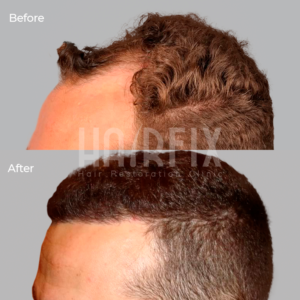Hair transplants are popular hair restoration treatments that have helped many men to recover not just their hair but also their confidence and self-esteem. However, many of them considering undergoing a hair transplant may be concerned about the possibility of scarring. So, are hair transplant scars permanent? Are they too noticeable? Today our hair transplant surgeons will give you the answer!
First, it’s essential to understand that a hair implant involves removing hair follicles from the donor area ( from the back of your head) and placing them into a recipient area where your hair is thinning or balding. The most known methods are “Follicular Unit Transplantation” (FUT) and “Follicular Unit Extraction” (FUE).

Tabla de Contenidos
Fut And FUE Hair Transplant Techniques
FUT involves removing a strip of hair from the back of the head with a scalpel, dissecting it into individual follicular units, and placing them into the recipient area. On the other hand, FUE involves removing individual units directly from the scalp using a small tool and then transplanting them into thinning hair or balding areas. Both methods can leave scars, but here’s the thing…
FUT scars are commonly long and run horizontally along the back of the head where the donor strip was removed. The scar’s length and width depending on the donor strip’s size, which can vary depending on the patient’s hair density and the number of grafts needed. FUT scars can be concealed with longer hair but are visible with any short hairstyle, such as a fade (from low to high).
FUE scars are much more minor throughout the donor area as individual follicular units are extracted. They are usually circular and range from 0.8mm to 1.5mm. These are less visible than FUT scars, as they can be easily hidden even with a fade!

So, My Hair Transplant Scars Will Be Visible?
With a FUT hair transplant, the answer is yes! With FUE, the tiny points will not be visible. Your hair volume and growth pattern will help you to hide those micro points.
FUE marks are much more minor throughout the donor area as individual follicular units are extracted. They are usually circular and range from 0.8mm to 1.5mm. These small points are less visible than FUT scars, as they can be easily hidden even with a fade!
Tips To Reduce Hair Transplant Scars
- Choose an experienced surgeon. An experienced and highly skilled hair transplant surgeon can minimize scarring by using the latest techniques; look for a surgeon with a great record of growing new hair and achieving natural-looking results.
- Choose FUE / DHI over FUT. FUE marks are smaller and only visible for a short period, making them the best option for those who want to achieve natural results without any marks.
- Avoid sun exposure. Sun exposure can make scars more noticeable, so protecting your scalp from the sun is essential. Wear a hat or use sunscreen specifically formulated for the scalp.
- Follow post-operative care instructions. Following the post-operative care instructions provided by your hair transplant surgeon is crucial in reducing the risk of scarring. These instructions may include avoiding strenuous physical activity, avoiding direct sunlight, and avoiding certain meds that can cause bleeding.
- Follow up with your surgeons. The specialists can provide additional tips and recommendations for minimizing the appearance of marks after your hair transplant. Finally, follow up with your hair transplant surgeon to check your healing progress and address any concerns or doubts you may have.
Hair transplant techniques, such as “Direct Hair Implantation” (DHI) and “Follicular Unit Extraction” (FUE), is known for leaving no visible scarring at all.
You May Also Like: All About Hatfishing And Hair Loss

DHI / FUE Hair Transplant
DHI technique involves using a unique tool that extracts and implants individual hair follicles. The tool creates tiny incisions in the balding or thinning area and places the follicles, eliminating the need for recipient incisions. This technique reduces the trauma to the scalp compared to FUT.
Compared to FUT (where it is necessary to cut a strip with a scalpel), FUE leaves tiny circular marks that are hard to see and easily hidden with any hairstyle. Similarly, FUE involves extracting individual hair follicles directly from the scalp using a small, circular punch. At Hairfix, our team of specialists performs only FUE / DHI techniques; here are the procedure steps:
- Donor Area Preparation. Our hair transplant surgeons evaluate the donor area from which the hair will be extracted. Then, the hair in this area is trimmed to facilitate the identification and removal of hair.
- Extraction Phase. The follicles are extracted from the scalp with a specialized tool that, with only 1 mm in diameter, allows the hair to be removed safely, precisely, without pain, and without the risk of leaving scars.
- Implantation Phase. The extracted follicles are now implanted in the areas affected by baldness, such as the crown or sides. Our experienced doctors control each implanted hair’s direction, depth, and angle, achieving natural-looking results.
- Healing And Hair Growth. Following the post-op care instructions indicated by your hair transplant surgeon will be fundamental in the first two weeks after your procedure. After a month, you will fully recover, and your hair will grow from the 4th month onward. The final results of your hair transplant will be fully appreciated within 12 months.
How Much Does A Hair Transplant Cost In Mexico?
At Hairfix, a hair transplant cost Mexico starts from $2990!
If you want to grow new hair to regain your confidence without going through the knife and without noticeable scars and pain, our staff is here to help. Our hair loss doctor in Tijuana have years of experience in hair transplant in Mexico and achieving natural-looking results with significant volume. Contact us to schedule an appointment today of hair loss treatment in Tijuana! Ask us about mesotherapy hair price and stem cell therapy for hair loss in Tijuana.






